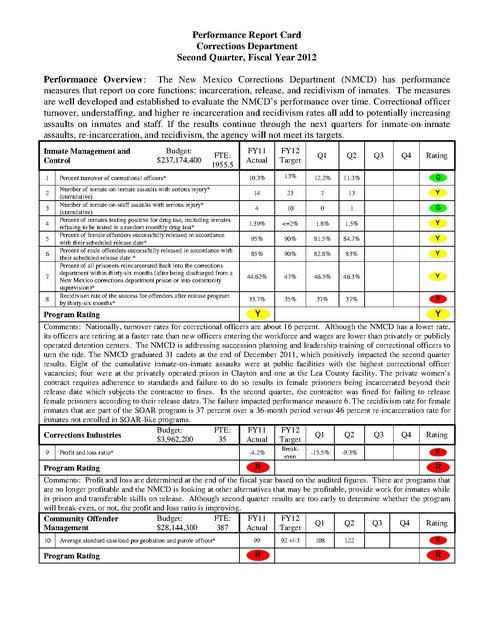Nm Doc Performance Report Card Second Quarter Fy2012
Download original document:

Document text

Document text
This text is machine-read, and may contain errors. Check the original document to verify accuracy.
Performance Report Card Corrections Department Second Quarter, Fiscal Year 2012 Performance Overview: The New Mexico Corrections Department (NMCD) has performance measures that report on core functions: incarceration, release, and recidivism of inmates. The measures are well developed and established to evaluate the NMCD’s performance over time. Correctional officer turnover, understaffing, and higher re-incarceration and recidivism rates all add to potentially increasing assaults on inmates and staff. If the results continue through the next quarters for inmate-on-inmate assaults, re-incarceration, and recidivism, the agency will not meet its targets. Inmate Management and Control 1 2 3 4 5 6 7 8 Budget: $237,174,400 FTE: 1955.5 Percent turnover of correctional officers* Number of inmate-on-inmate assaults with serious injury* (cumulative) Number of inmate-on-staff assaults with serious injury* (cumulative) Percent of inmates testing positive for drug use, including inmates refusing to be tested in a random monthly drug test* Percent of female offenders successfully released in accordance with their scheduled release date* Percent of male offenders successfully released in accordance with their scheduled release date * Percent of all prisoners reincarcerated back into the corrections department within thirty-six months (after being discharged from a New Mexico corrections department prison or into community supervision)* Recidivism rate of the success for offenders after release program by thirty-six months* FY11 Actual FY12 Target Q1 Q2 10.3% 13% 12.2% 11.3% 14 23 7 13 4 10 0 1 1.39% <=2% 1.8% 1.5% 95% 90% 81.5% 84.7% 85% 90% 82.8% 83% 44.62% 47% 46.5% 46.3% 33.7% 35% 37% 37% Q3 Q4 Rating Program Rating Comments: Nationally, turnover rates for correctional officers are about 16 percent. Although the NMCD has a lower rate, its officers are retiring at a faster rate than new officers entering the workforce and wages are lower than privately or publicly operated detention centers. The NMCD is addressing succession planning and leadership training of correctional officers to turn the tide. The NMCD graduated 31 cadets at the end of December 2011, which positively impacted the second quarter results. Eight of the cumulative inmate-on-inmate assaults were at public facilities with the highest correctional officer vacancies; four were at the privately operated prison in Clayton and one at the Lea County facility. The private women’s contract requires adherence to standards and failure to do so results in female prisoners being incarcerated beyond their release date which subjects the contractor to fines. In the second quarter, the contractor was fined for failing to release female prisoners according to their release dates. The failure impacted performance measure 6. The recidivism rate for female inmates that are part of the SOAR program is 37 percent over a 36-month period versus 46 percent re-incarceration rate for inmates not enrolled in SOAR-like programs. Budget: FTE: FY11 FY12 Q1 Q2 Q3 Q4 Rating Corrections Industries $3,962,200 35 Actual Target 9 Profit and loss ratio* -4.2% Breakeven -15.5% -9.3% Program Rating Comments: Profit and loss are determined at the end of the fiscal year based on the audited figures. There are programs that are no longer profitable and the NMCD is looking at other alternatives that may be profitable, provide work for inmates while in prison and transferable skills on release. Although second quarter results are too early to determine whether the program will break-even, or not, the profit and loss ratio is improving. Budget: FTE: FY11 FY12 Community Offender Q1 Q2 Q3 Q4 Rating $28,144,300 387 Actual Target Management 10 Average standard caseload per probation and parole officer* Program Rating 99 92 +/-3 108 122 Performance Report Card Corrections Department Second Quarter, Fiscal Year 2012 Comments: The probation and parole caseloads will remain high past the second quarter of FY12. The 15 new hires will decrease per officer caseloads after the officers fully assume their assigned parolees or probationers cases. During the 2012 legislative session, Senate Bill 162 would have increased the statutory intensive supervision caseload requirement to 40 from 20 cases; however, it failed to pass the Senate. The overall average caseload per officer would not go down with a statutory change but it would lead to a more balanced caseload assignment. * Denotes House Bill 2 measure




